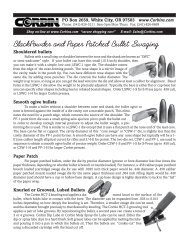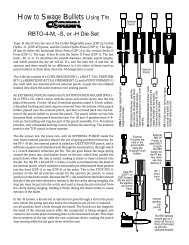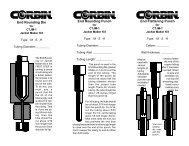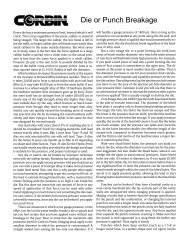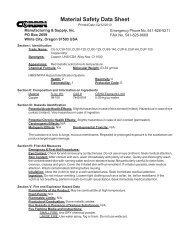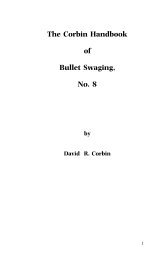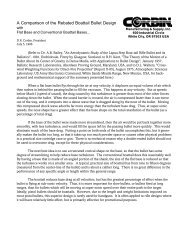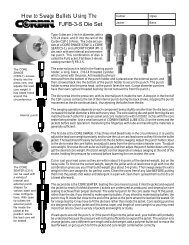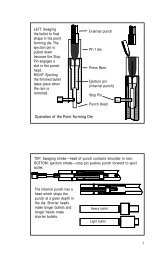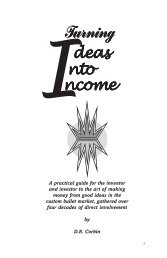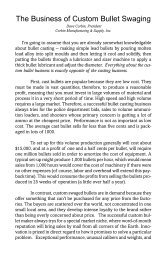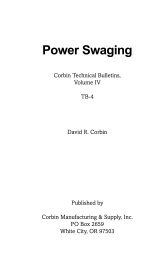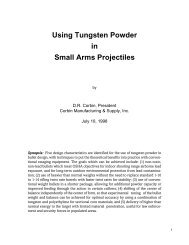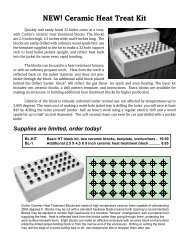HB-9 updated text (PDF) - Corbin Bullet Swaging
HB-9 updated text (PDF) - Corbin Bullet Swaging
HB-9 updated text (PDF) - Corbin Bullet Swaging
Create successful ePaper yourself
Turn your PDF publications into a flip-book with our unique Google optimized e-Paper software.
a 3/4-E (elliptical ogive with a length of 0.75 times the caliber) handgun<br />
bullet is inherently no less accurate than the regular 9 or 10 degree truncated<br />
conical bullet (truncated means cut off, and the TC is a spire shape<br />
with the end cut off, usually at about 40% of the caliber). Whichever you<br />
like best and feeds best in your gun is the one to use.<br />
A common request is for dies to make a bullet with some arbitrary BC<br />
number, usually higher than anything else on the market from mass producers.<br />
But this is a little like spending all your money on a great set of<br />
magnesium wheels for your car, so you have nothing left for the engine or<br />
body work. Lots of teenagers did that when I was of that age. Today I<br />
hear the thumping of huge, overpowered speakers from expensive stereos<br />
coming from cars that could use a paint job and a tune-up, usually<br />
with the same genre of fuzzy-minded youthful driver who spent his burgerflipping<br />
paycheck for “cool mags” back in the ‘fifties.<br />
Putting all your attention on the ballistic coefficient and ignoring most<br />
of the other factors is very little different. The real goal is usually to hit<br />
the target at long range with greater reliability. Confusing the real goal<br />
with some narrow part of the total package that will get you there is a<br />
problem created by the myth that somehow, an arbitrary BC number<br />
bigger than anything available currently means the bullet will be more<br />
accurate.<br />
Sorry, but the BC is only a relative measure of inverse air resistance<br />
compared to some standard bullet, such as the one-inch artillery projectile<br />
that has been considered a 1.0 on the BC scale for decades. The BC<br />
means nothing by itself. You must also know the standard against which<br />
it is compared, and advertising sometimes plays on this fact to overstate<br />
the comparison or ratio by subtle use of a different standard projectile.<br />
For example, I could easily publish BC numbers of 2.50 or 3.59 or<br />
anything else I wanted, whereas most BC numbers are less than 1.0. How?<br />
By noting in the fine print, which no one reads, that the standard projectile<br />
used for comparison is a five grain wad of newspaper chewed to a<br />
soggy consistency and fired from a pursed pair of lips (yes, a spitball).<br />
More subtle yet, I could simply assume that everyone “knew” I was using<br />
a conventional 6-S 168 grain spitzer flat base bullet as my “standard”, and<br />
then publish comparison BC numbers relating the bullets I was attempting<br />
to market to this standard.<br />
Not drawing any particular attention to the standard just reinforces<br />
the myth that BC has some independent value as a figure of merit. It is in<br />
fact a ratio, so it requires two items for comparison and has no meaning<br />
otherwise. Stating the BC alone is like saying the odds of the Atlanta<br />
Braves winning the next game against the Giants is “3”. But three compared<br />
to what? You might assume 3 to 1. Maybe the Giants fan meant 3 to<br />
35



